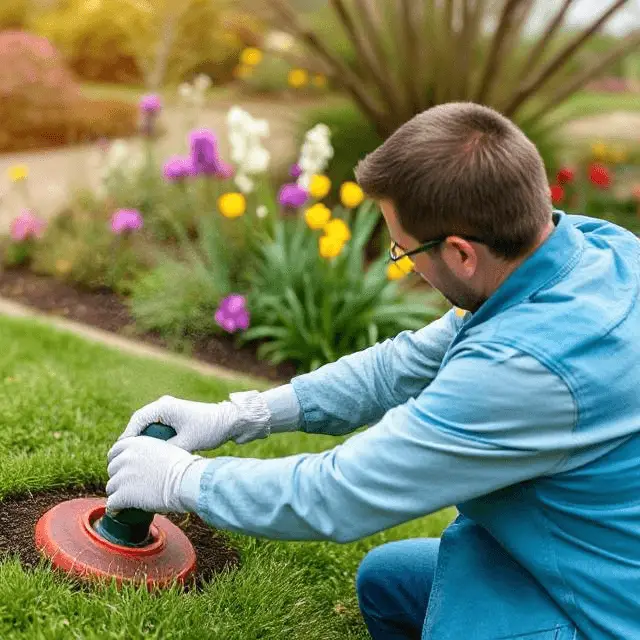How to Tell If Your Lawn Needs Lime
Last Updated on August 2, 2024 by Duncan
Also known as garden lime, lime is derived from burnt limestone, and it contains potassium, calcium, and magnesium. Its primary role is to balance the soil pH so your grass and other plants can access macronutrients.
Now and then, especially if you live in areas with acidic soils, you need to apply lime to your yard.
How to tell if your lawn needs lime
The most accurate and reliable way to tell your lawn needs lime is to undertake a soil test and measure the soil pH in your lawn. The test will also help you know the micronutrient, phosphorus and potassium levels in your yard.
Wondering where to do the testing?
Well, in most states, the Extension Service provides soil-testing services at a fee, and all you need to do is to take your soil sample to the lab, and they will test it.
If you don’t want to take your soil there or are a DIY enthusiast, you can buy a soil test kit from the extension service offices, through the commercial soil testing labs or online and test the soil by yourself at home.
Most grass varieties can tolerate wide pH ranges (5.5 -7.5), but the ideal value is 6.5. At this pH, the grass can easily draw nutrients from the soil, so it grows healthy.
Therefore, if after the soil test the pH is below 6.5, you need to add lime to your lawn.
How much lime to add to the lawn?
Now that you have determined that your pH levels are low and you need to raise them, the big question is how much lime you need to add to the lawn.
The amount to add depends on the pH levels of your lawn. For example, if your soil pH is below 5.5, you need to add up to 50 pounds (23kg) of lime per 1000 square feet (93 m2).
If your pH levels are too low, you may need to apply lime in split applications (such as every 3 weeks) as you shouldn’t apply more than 100 pounds of lime per 1000 square feet or else you damage your grass.
If you aren’t sure about the right amount of lime to apply to your lawn, consult your extension office.
Should you apply lime before the rain?
Yes, you should apply lime before it rains, but the ground shouldn’t be frozen or going through extensive heat or drought stress.
The best time to lime your lawn is fall. The reason for this is because fall coincides with the over-seeding season. Also, the rain will increase in the coming winter season, which will drive the lime deep in the ground.
The freezing and thawing cycles in the coming months will come in handy at breaking down the lime and helping it penetrate deep into the soil.
For the best outcome, don’t apply lime in an overly wet or dry lawn. Give your lawn time and do it when you have dry, cool weather.
When applying lime in fall, remember to moisten the soil to promote its penetration into the deeper soil layers.
How to apply lime to your lawn
For an even application, apply half of the total amount of lime you need in one direction, then the other half going in the opposite direction. For an easy time, use a garden spreader such as Scotts broadcast spreader that is easy to use, and you can use it both on large and small lawns.
To make it easy for the lime to reach the deeper soil layers, apply lime after you have aerated your lawn.
After applying lime, water the area to ensure that the lime is well incorporated into the soil and not stuck on the grass.
Can you add lime to fertilizer during application?
To attain the right coverage and use the right amount of each product, I would discourage this and apply each product at separate times.
The best way to go about it is to apply lime three weeks before applying fertilizer. If you do a soil test and find the soil too alkaline, apply sulfur to correct it.
How long does it take for lime to work on grass?
The time it takes to see results depends on the soil pH. If the pH wasn’t too low, it could take just a few months for the grass to turn green and lush, but if the pH was too low, you might have to apply lime a few times before you fix the imbalance and the grass flourishes.
Does lime kill grass?
Lime is meant to help achieve beautiful, healthy, green grass, but it can also destroy the grass, so if you are asking does lime kill grass, yes, it does.
This often happens when you apply too much lime to your grass or use the wrong lime type.
When you apply a lot of lime to your lawn, you increase the soil pH, and the soil becomes too alkaline, which significantly impacts the ability of the grass to uptake the vital nutrients.
Grass growing in highly alkaline areas tends to be iron deficient, and this causes it to turn yellow and have bleach spots on its blades. If you don’t fix the issue early enough, the grass dies.
To fix the iron deficiency in your grass, you need to use Milorganite, Ironite, or any other iron supplement.
High lime content in the grass also leads to increased calcium in the soil that blocks the ability of the soil to absorb magnesium. Again, if you don’t fix this, the grass dies.
As mentioned above, grass can also die from using the wrong lime.
There are two main types of lime you can apply to your lawn: dolomitic and calcitic lime.
Dolomitic lime contains magnesium and calcium, and it’s best to use when your soil is deficient in magnesium and has a low pH reading.
Calcitic lime, on the other hand, is derived from calcium carbonate deposits and often lacks the magnesium you will find in dolomitic lime.
If you use the wrong lime type, you are bound to kill your grass. For example, if your soil test results show that your soil is not deficient in magnesium and you go ahead and apply dolomitic lime, you will kill your grass as you will oversupply it with magnesium.
To avoid this, always do your research or consult an expert to ensure you are applying the right lime type.
Lime comes in three main forms: pulverized, granular and hydrated lime.
Pulverized lime is fast-acting, but since it’s in powder form, it tends to clog the spreader, so you have to apply it by hand, which, as you can tell, is time-consuming. The powder nature of the lime also means that it can easily be blown away by the wind during the application or even get into your eyes.
Granular lime comes in pellets, so you can easily spread it with a spreader. The downside to it is that it takes a long time to break down, so it might take you a long time before seeing the impact of your application.
Hydrated or liquid lime is extremely fast-acting, and you apply it using a sprayer. Unfortunately, it’s hard to judge the amount you have applied to a given area, so you should avoid using it as you can easily over lime your lawn and end up killing your grass.
So, how to tell if your lawn needs lime?
The key to telling it’s time to apply lime to your lawn is to test your soil and determine your soil pH.
When collecting the soil samples, avoid picking them from recently fertilized or wet areas. Also, don’t take samples from recently limed areas.
When shopping for lime, go with granulated or pelletized lime as it’s easy to spread using a rotary or handheld spreader.
It takes time for lime to work on your grass, so you need to be patient to see significant progress and recovery of your grass.


